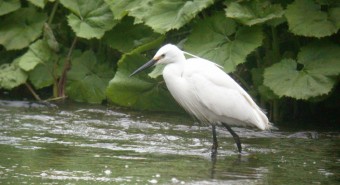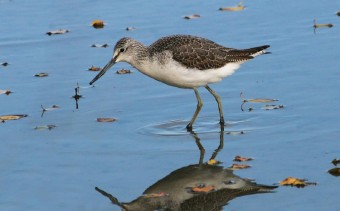Monitoring water birds on the Helford River
In recent weeks, volunteers from the Helford Voluntary Marine Conservation Area have developed a plan to count waterbirds on the Helford as part of the Wetland Bird Survey (WeBS). Ilya Maclean, WeBS co-ordinator for Cornwall and local resident Martin Rule, explain why counting waterbirds is important, which waterbirds are found on the Helford and how participating in WeBS helps to conserve these species.
 Photo by Jill Packenham
Photo by Jill Packenham
 Little egret. Photo by Andy Musgrove
Little egret. Photo by Andy Musgrove
 Photo by Jill Packenham
Photo by Jill Packenham
Areas of intertidal mudflats in the UK, such as those along the shores of the Helford River, are of outstanding international importance for many species of waterbird. Lying on some of the major flyways for Arctic-nesting species, large numbers of waterbirds are attracted, especially during winter, by the relatively mild climate and extensive areas of mudflats they provide them with their food. The conservation of the mudflats on which these birds depend is vital in a global context, if healthy populations of these species are to be sustained.
Monitoring waterbirds is an important part of conservation. Without knowing how numbers are changing through time, it is impossible to know which species and areas are most threatened by our changing environment, or indeed which aspects of our changing environment have the biggest impact. Estuaries and other wetlands have experienced many changes in recent years. Developments threaten feeding habitats, water quality has altered, the climate has warmed and fish stocks have been depleted.
How does this threaten our birds? Where does this threaten our birds? Without monitoring, we wouldn’t know. Moreover, often there isn’t enough money to conserve everything, or conservation might come at the expense of other things we enjoy, such as boating. Monitoring is an essential means of establishing where our priorities should lie.
This is where the Wetland Bird Survey (or WeBS as it is often abbreviated to) comes in. WeBS is the monitoring scheme for non-breeding waterbirds in the UK and provides the principal data for the conservation of their populations and habitat. It is a partnership initiative between the British Trust for Ornithology, the Royal Society for the Protection of Birds and the Joint Nature Conservation Committee. Continuing a tradition begun in 1947, around 3,000 volunteer counters throughout the UK, participate in synchronised monthly counts at wetlands of all habitat types, mainly during the winter period.
The data collected as part of the Wetland Bird Survey are used to assess the size of waterbird populations, determine trends in numbers and distribution, and assess the importance of individual sites for waterbirds, in line with the requirements of international Conventions and Directives designed to protect waterbirds. For example, WeBS data have underpinned the designation of over 100 protected areas and have helped to investigate the key drivers of waterbird population change, which include climate change, loss of habitat, disturbance and introduced non-native species.
On 16th January 2011, volunteers from the HMCG started what is hoped to become a long-term involvement in WeBS. Previous attempts at covering the Helford have been difficult, given the low number of viewpoints and the time taken to move between them. It is therefore fantastic to be able to report that seven local recorders were able to divide the site up into sectors so that nearly the whole estuary was counted before inclement weather arrived at 10am. While it is always dangerous to start commenting on a small dataset – one survey – it is also impossible not to make some interesting observations. For example, only 4 Grey Herons were recorded and 8 Little Egrets. Perhaps others were ranging farther afield in the farmland and wetlands in the hinterland? Conversely, 39 Shelduck, 129 Mallard and 215 Curlew give us quite high figures for these species against which to compare the future surveys. A full list of the findings can be seen on our website.
The Helford is one of the mildest areas of wetland habitat in the UK. As a consequence it hosts good numbers of several species that are more commonly found further south in Europe and reach the northern extremities of their range in the UK. Being one of the warmest wintering sites for waterbirds in the UK, means that events that occur here are often a harbinger of things to come elsewhere in the UK. Despite the recent adverse weather, the climate in this part of Cornwall, in common with elsewhere in the UK, has actually warmed by two degrees C since the 1970s.
Those of you living near the Helford may be aware of the numbers of a species that was able to colonise the UK as a result of these warmer temperatures: the Little Egret. Although sporadic records occurred before this time, this elegant white bird in the Heron family first colonized the UK in significant numbers in the mid-1980s. By 1993, numbers peaked at 185, with more than half the records from estuaries in Cornwall. Since that time it has expanded rapidly. By 2003 more than 4,000 were counted by volunteers participating in the Wetland Bird Survey and numbers in 2010 were probably in excess of 10,000. From its origins in warm estuaries in the south-west, it has expanded through much of the UK and now even occurs occasionally in Scotland. Other species associated with warmer climes, such as Greenshank, have also increased rapidly in the UK, although warm sites such as the Helford remain its stronghold. Conversely, some species have fared less well in the south-west. Birds such as the Redshank and Curlew, once more common in Cornwall, have foregone the benefits of mild temperatures in favour of more productive feeding grounds on the east coast. It will be interesting to see whether this species declines on the Helford if temperatures continue to increase. However, climate change is by no means the only factor likely to be affecting waterbirds on the Helford. Monitoring how numbers are changing will allow us to understand what these are.
Ilya Maclean and Martin Rule
Extract from HVMCA newsletter No.42 Spring 2011







